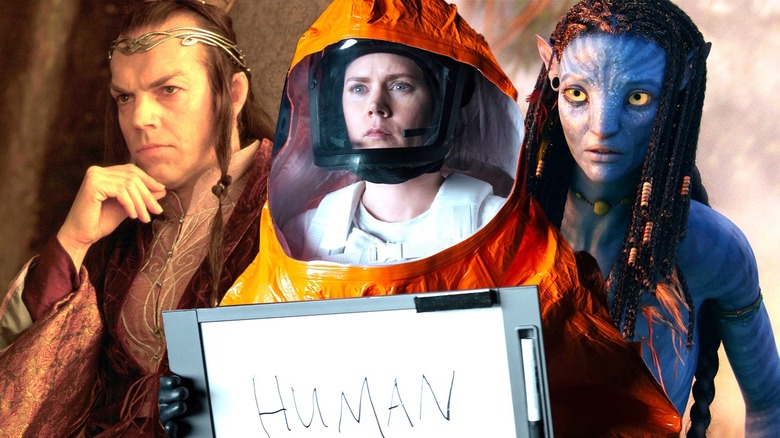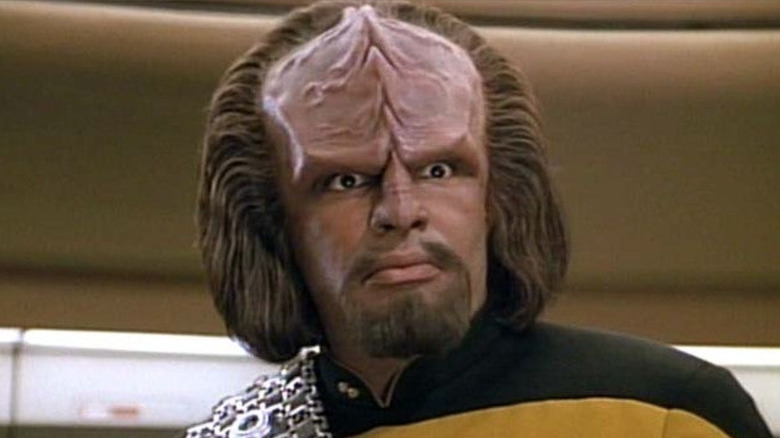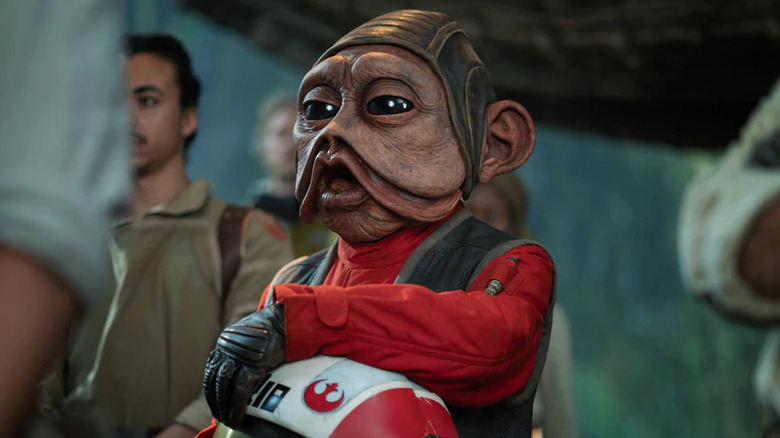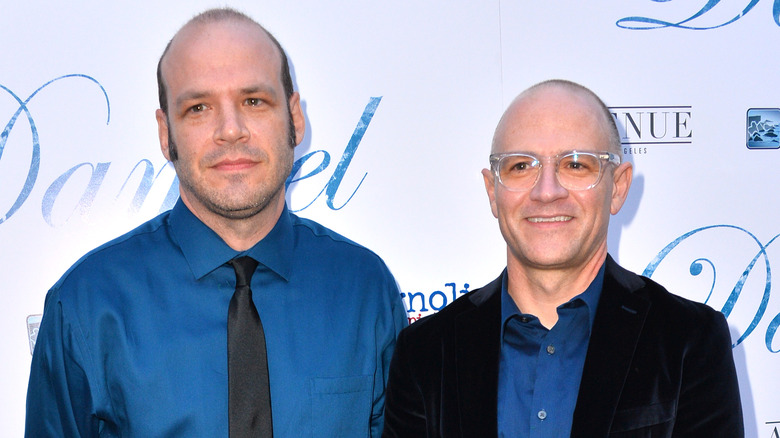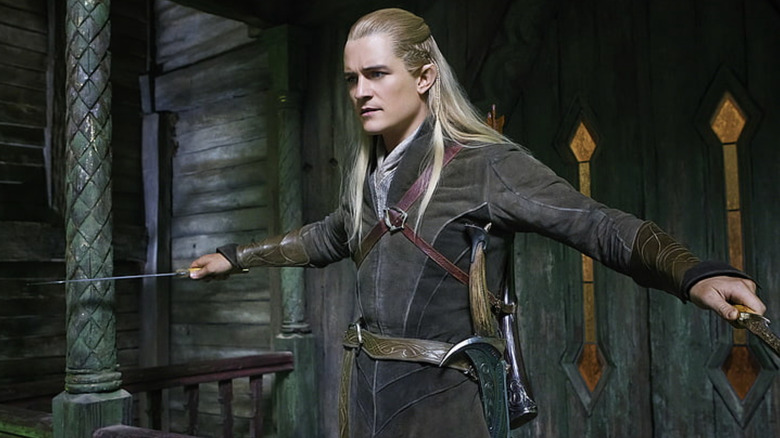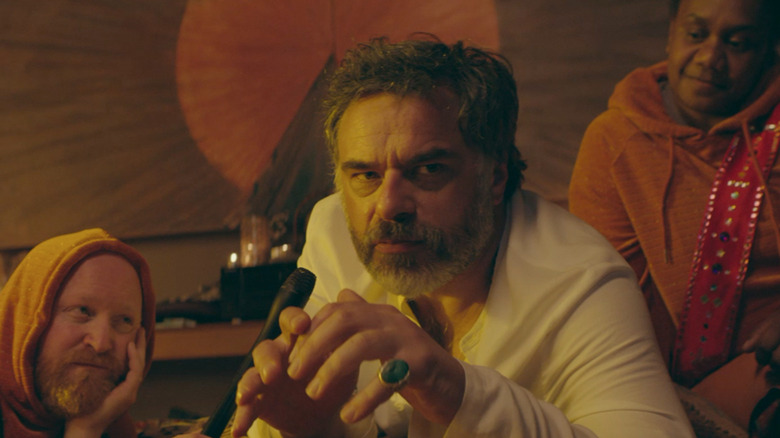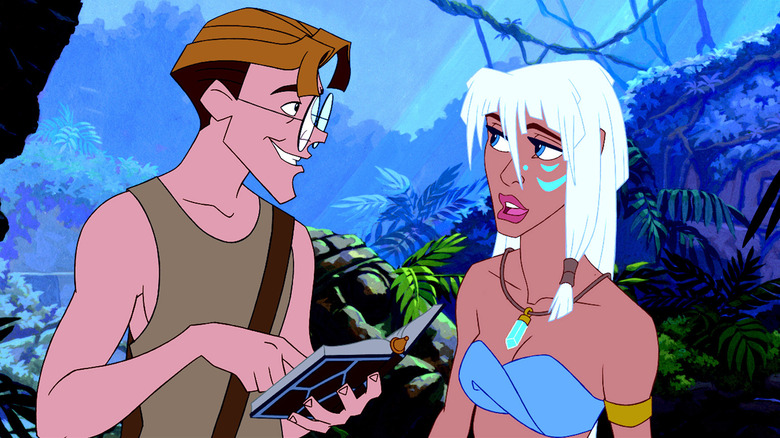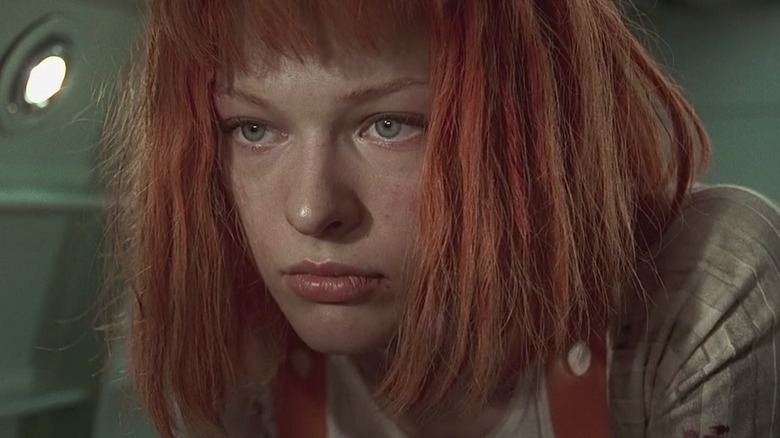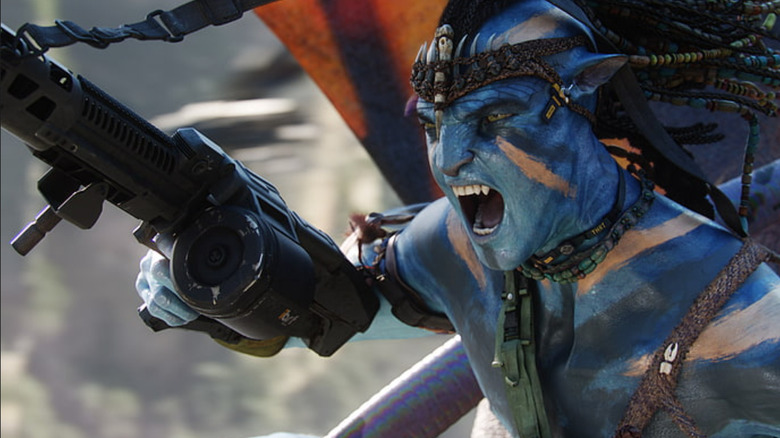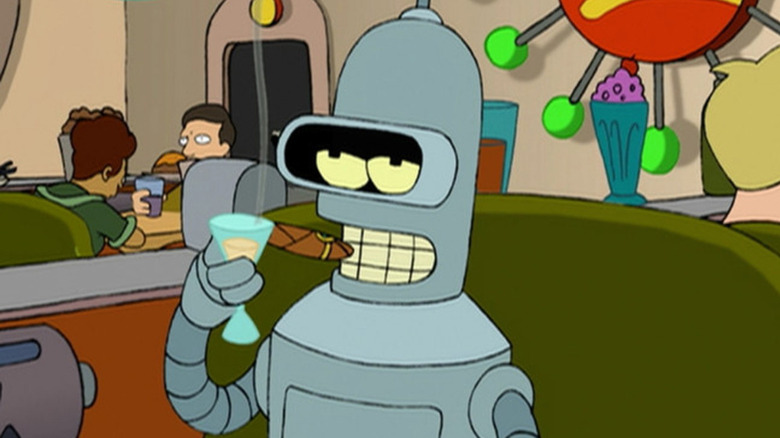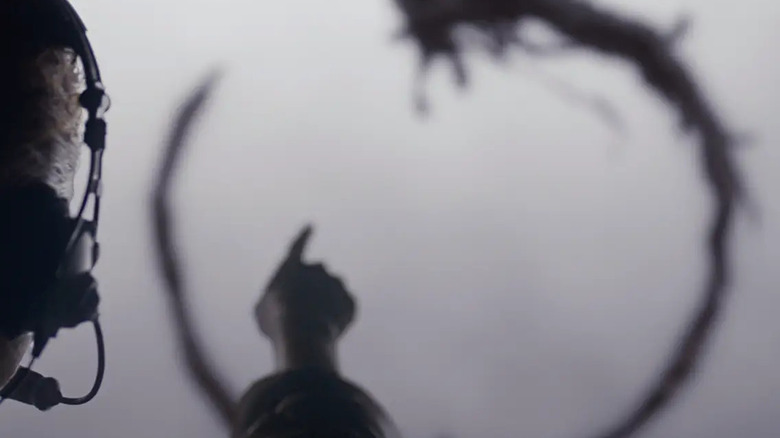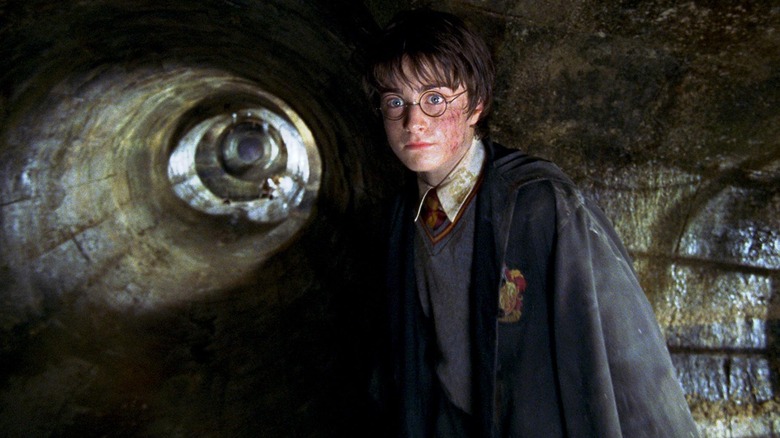13 Fake Languages Made Up For Movies And TV Shows
There are more than 7,000 languages spoken in various countries all around the world. Thanks to creative storytellers, there are a few more fictional languages to add to the list that are not natively spoken by any culture on the planet.
Language is the foundation of storytelling, but for some stories, pre-existing languages aren't enough. Whether they're spoken by an alien species or a race of fantasy creatures, the introduction of a fictional language sometimes becomes necessary. For many films and TV shows, gibberish or non-verbal noises are enough to get the point across. Other stories go above and beyond and flesh out their fictional languages with entire alphabets and lexicons.
Creating a believable and fully realized language from scratch is a monumental challenge. Delivering on this tall order isn't as simple as making up a bunch of fake words. The task requires a thorough understanding of the science of sound, the nuance of written and verbal communication, the intricacies of different grammatical systems, and even in-depth anatomical knowledge to tailor the language to the specific entity who will be speaking it. The most refined fictional languages have complete grammar, syntax, and vocabulary, allowing them to be used in the same way a real-world language would be. The following languages are all developed enough to be spoken aloud conversationally or used for extensive written communication.
Klingon - Star Trek
One of the most popular fictional languages throughout all of pop culture is undoubtedly Klingon. This alien language can be found in the expansive world of the "Star Trek" franchise. The language was described in the first iteration of the television series but wasn't spoken aloud until 1979's "Star Trek: The Motion Picture." The foundation of this alien language was actually devised by actor James Doohan, who played Scotty. He created the dialogue and the general sound of Klingon for the film. The language was then further developed by linguist Marc Okrand, who also helped develop the Vulcan language for the "Star Trek" franchise.
TlhoS nIvqu' tlhIngan qul tera'. That's Klingon for, "The Klingon language is robust enough to carry out complex conversations." Back in 2006, the "Guinness Book of World Records" named Klingon as the largest fictional language in existence. Some "Star Trek" fans are able to speak fluently in the language and even use Klingon to create original song lyrics. There are several online programs that translate English into Klingon and vice versa, allowing anyone to try out the language for themselves, though pronouncing the language correctly is another challenge in itself.
Dothraki & Valyrian - Game of Thrones
In George R.R. Martin's "Game of Thrones" book series, the richly detailed world is full of different races and species, many of which have their own languages. When it came time to bring the books to the small screen with the HBO series, a great deal of work was required to figure out how to have characters speak these fictional languages aloud. Linguist David J. Peterson was brought on board the series as the resident language creator for "Game of Thrones." Peterson created both Dothraki and Valyrian for "Game of Thrones," and has created fictional languages for numerous other properties, such as The Shannara Chronicles.
Peterson's task was to devise a complete language that could be used to translate any dialogue the writers came up with for the Dothraki people, and two interconnected language sets for the Valyrian people, who divide their language into High Valyrian and Low Valyrian. He had the added challenge of needing to make his constructed languages fit seamlessly into the world of the pre-existing novels.
The full Dothraki vocabulary consists of about 4,000 words in total. However, the language features a complete grammar system, which allows the potential of its lexicon to be nearly infinite. The established vocabulary is large enough to allow for fluent conversation, and the grammatical rules of Dothraki allow the flexibility to translate any conceivable sentence by using substitutions for missing vocabulary or creating new words that fit into the system.
Aurebesh, Huttese, and More - Star Wars
With countless movies, TV shows, books, video games, and comics, the "Star Wars" franchise is almost as vast as the galaxy it is set in. There are dozens of different languages in "Star Wars" spoken by humans, aliens, and droids. Not all of these languages are fully developed and able to be employed in conversation, but some are actually real languages that exist on Earth that have had their names changed to sound alien.
In the original trilogy, real Indigenous languages were frequently used to take the place of alien languages on screen. The South American language Quechua was used for Greedo's dialogue and served as the basis of the broader Huttese language. The character Nien Nunb speaks in the alien language of Sullustese, but his dialogue is actually spoken in Haya and Kikuyu, which are both native to Kenya.
One truly fictional language that was created for the "Star Wars" universe is Aurebesh. The language is seen on screen and in printed form, but cannot be spoken aloud. Aurebesh is an alphabet and corresponding written language that correlates to the spoken language known as Galactic Basic. The majority of characters throughout the "Star Wars" franchise speak in Galactic Basic, which is the language that the audience perceives as English. Any word in the English language can be easily translated into the Aurebesh language via alphabetic transliteration.
Bulbovian - Frontier
"Frontier" is a seldom-seen indie film from filmmakers David and Nathan Zellner. The duo went on to make bigger and more accessible movies like "Kumiko, the Treasure Hunter" and "Damsel" with Robert Pattinson, but "Frontier" arrived at the very beginning of their careers, when they were working with hardly any resources at the extreme end of the arthouse spectrum.
Released in 2001 and shot on low-quality video, "Frontier" is easily one of the most bizarre movies ever made. The story follows a pair of men who head to a mysterious forest to claim the land for the country of Bulbovia. What begins as a Lewis & Clark-type expedition soon leads to gross and inexplicable happenings like cockroach-eating, spider-web licking, a man having sex with the forest itself, a Sasquatch monster playing with a yoga ball, and much more.
In case you didn't know, the country of Bulbovia does not exist in real life, nor does its Bulbovian language. Nevertheless, 100% of the dialogue and on-screen text in "Frontier" is delivered in the fictional Bulbovian language, which is designed to look and sound vaguely Soviet in nature. The Zellner brothers devised the fake country and language for the film and also featured it in an animated PSA designed to promote the sale of Bulbovian war bonds.
Elvish - Lord of the Rings
J.R.R. Tolkien, the author of "The Lord of the Rings" book series, was a polyglot obsessed with all things relating to language. He was fluent in numerous languages spoken all around the world and was well-versed in many dead languages as well. While he was building the world that would become the setting for "The Lord of the Rings," he decided to create his own languages that would be spoken by the different races of Middle Earth.
Tolkien holds the distinct trailblazing honor of being the first author to develop a constructed language with a full vocabulary and grammar system that could be written and spoken fluently. While he created elements for the languages of several different races across Middle Earth and beyond, some of the most fully developed were the languages spoken by the elves. Colloquially, these languages are often referred to simply as Elvish, but there are multiple elven languages under that umbrella term. Sindarin and Quenya are two distinctly different elven dialects, and Tolkien fleshed them both out fully.
Even before he was writing "The Lord of the Rings," Tolkien had dabbled in language creation. About half a century before the first novel was published, Tolkien participated in the creation of the Nevbosh language alongside his cousin Mary Incledon, who also created languages from scratch. Tolkien later evolved Nevbosh into a second constructed language known as Naffarin, which is considered to be a direct predecessor to his Quenya language.
Zøbftańlik - Nude Tuesday
Released in 2022, "Naked Tuesday" AKA "Nøken Tisdøg" features perhaps the most recent fictional language brought to the silver screen. The language in question is known as Zøbftańlik and is designed to sound generally Scandinavian when spoken aloud without actually borrowing from any of the five pre-existing Scandinavian languages of Danish, Norwegian, Icelandic, Swedish, and Faroese.
100% of the dialogue in "Nude Tuesday" is spoken in Zøbftańlik in a comedic plot that follows a married couple who head to a cult-adjacent commune to work on their relationship. To make matters even more unorthodox, the language is not translated directly into subtitles for the audience. Instead, the subtitles were written after the fact by a comedian who had no comprehension of the Zøbftańlik language, making his best guess as to what was being said.
The language was devised by actor and vocal coach Perry Piercy, who had no background in linguistics. Piercy built a basic lexicon to start with and allowed the actors to contribute additional Zøbftańlik vocabulary throughout a group rehearsal period ahead of shooting. Zøbftańlik itself has rules and a set of words, but was also built with a high degree of malleability to allow the cast to improvise their lines, resulting in a language that is partially pre-determined and partially fluid.
Atlantean - Atlantis: The Lost Empire
The Disney animated movie "Atlantis: The Lost Empire" took the concept of the mythical underwater city and developed it into a full-blown world for exploration and adventure. The main character Milo (voiced by Michael J. Fox) is a linguist, and his vast knowledge of language is key in locating the lost city of Atlantis. This heavy focus on language in the plot makes it perfectly appropriate that a complete language was devised for the film to be spoken and written by the citizens of the lost empire.
Atlantean, also known as Dig Adlantisag, goes an extra step beyond most fictional languages by having its own alphabet and numerical systems as well as having a complete lexicon of words and phrases. Dig Adlantisag also features its own special language rules, such as disregarding punctuation and capitalization. Most interestingly, it needs to be read in a snaking pattern known as boustrophedon, which requires each line to alternate between flowing left-to-right and right-to-left, as Milo discovers in the film. The fictional language was created by the team of Disney's John Emerson (who designed the look of the Atlantean alphabet) and linguist Marc Okrand, who had earlier developed the Klingon language for the "Star Trek" franchise. The Dig Adlantisag language returned in the sequel "Atlantis: Milo's Return," video game spinoffs, and, oddly enough, in the unrelated "Rune Factory" video game series.
The Divine Language - The Fifth Element
"The Fifth Element" is a 1997 sci-fi action film from director Luc Besson. Throughout his career, Besson has repeatedly returned to the action and sci-fi genres, but he only went as far as to create a fully-functioning fictional language for "The Fifth Element." Although he utilized a primitive fake language in "Valerian and the City of a Thousand Planets," the only complete language devised for one of his movies was The Divine Language, spoken by Leeloo (Milla Jovovich).
She picks up a few English words along the way, but the vast majority of Leeloo's dialogue is spoken in The Divine Language and is left completely unsubtitled, leaving what she says a mystery to the audience. Though the dialogue has the potential to sound like gibberish upon first listen, it is a developed language with a remarkably robust set of 400+ vocabulary words. Besson is thought to have created The Divine Language's lexicon singlehandedly, though he has kept the specifics of his language creation process close to the vest over the years. One superfan of "The Fifth Element," T. Leah Fehr, compiled an unofficial "Divinian" dictionary, which is nearly 100 pages long and fleshes out the language in exacting detail. Although the dictionary was, of course, based on the dialogue spoken in the film and compiled from other sources involved in the production, many liberties needed to be taken in order to complete the vocabulary of The Divine Language.
Nadsat - A Clockwork Orange
Stanley Kubrick's classic 1971 film "A Clockwork Orange" was adapted from the novel of the same name written by Anthony Burgess. Kubrick was notorious for changing elements of the books he adapted with little regard for the source material. While he certainly simplified its usage a bit in the film version, one element of the novel that made it to the big screen intact was Nadsat, the fictional language spoken by the gang of droogs.
This language, which is also sometimes referred to as droog speak, was created for the novel by Burgess himself. The language was intended mainly as a hybrid between English and Russian and pulled influence from Cockney rhyming slang of London, which started out as coded speak used by criminals before gradually disseminating to the broader populace. Since Nadsat is spoken specifically by criminal youths in "A Clockwork Orange," it can be classified as both a language and an argot, which is the hidden vocabulary of a select group.
The Nadsat language is complex enough that it has become a long-term subject of study for professors, linguists, authors, and translators — even though Burgess wished for his fictional language to remain somewhat opaque and mysterious. He preferred that his readers be required to use context and critical thinking to figure out what the droogs were saying rather than spelling out the meaning of their slang. Burgess wrote in his memoir "You've Had Your Time: Second Part of the Confessions," "The novel was to be an exercise in linguistic programming, with the exoticisms gradually clarified by context." Against his explicit requests, glossaries that defined Nadsat terms were included in some editions of the novel.
Na'vi - Avatar
When it hit theaters in 2009, James Cameron's "Avatar" smashed box office records to become the number one highest-grossing film of all time. Pulling off this feat meant dethroning his own "Titanic," the previous top-grossing film. Alongside the unprecedented technological advancements and flashy visuals of "Avatar," one of the biggest draws for audiences was the richly detailed world of Pandora.
The Na'vi people, flora and fauna, geographical formations, and entire complex ecosystem were designed to make the world of Pandora feel distinct. Part of the worldbuilding that went into "Avatar" was the creation of the Na'vi language, which is one of the most comprehensively constructed languages in the history of cinema. Cameron contributed to the start of the Na'vi lexicon, but the majority of the language's intricacies and vocabulary were devised by linguist Paul Frommer, who pulled influence from the languages of Polynesia.
The Na'vi language is complete enough for complex conversations to be carried out about virtually any subject, and anyone willing to put in the effort can become fluent in Na'vi, thanks to the numerous dictionaries, translators, and educational resources available online. Some extremely devoted "Avatar" fans have taken on the Na'vi language in a more extreme capacity and converse with it regularly. Members of the community known as Kelutral consider themselves Na'vi scholars — they have been studied by MIT researchers and can even be heard speaking Na'vi in an episode of HBO's "How to With John Wilson."
Alienese - Futurama
The animated comedy series "Futurama" has run for 11 seasons and survived multiple cancellations and network changes. While the show is mostly goofy fun, it has shown a propensity to dig a bit deeper from time to time. This surprising depth might come in the form of unexpectedly hard-hitting emotional moments, or from the impressive amount of work that the folks who make the show put into easter eggs and hidden gags. Alienese within "Futurama" is both a fictional language and one of the show's most impressive inside jokes.
Alienese is never spoken aloud but appears in written form all throughout the series, first appearing as early as the show's opening credits sequence. The written form of Alienese uses a unique alphabet — or rather, two unique alphabets. Alienese can actually be divided into Alien Language 1 and Alien Language 2, with each decipherable in a different manner. The languages are used to hide additional visual gags in plain sight for only the fans dedicated enough to crack the code. At various times, the languages have been referred to by those involved in making the show as Alienese, Alien Language, and Nibbolonian. Series co-creator David X. Cohen revealed that three alien languages were created for the show, but the third was never featured on-screen because it was too complicated.
Heptapod - Arrival
Denis Villeneuve's 2016 sci-fi film "Arrival" is as much about language as it is about aliens. The film's core conflict revolves around the challenges of communication across language barriers. The main character, Louise (Amy Adams), is a linguist brought in by the U.S. military to figure out how to communicate with the aliens, which are known as Heptapods. Her linguistic expertise is essential to the plot and is reflected in the film's presentation of the Heptapod language as a form of communication that is unlike anything found on planet Earth.
The aliens' language can be broken down into two types: Heptapod A, which is their verbal speech, and Heptapod B, which is their written speech. Heptapod A is completely unintelligible to the characters, and resembles whale songs more than any human language. Heptapod B is what is known as a semasiographic language and appears as intricately designed ink rings that materialize in three-dimensional space, which are known as logograms and are meant to be interpreted without a defined beginning or end. The film dives deep into the linguistics, math, and science necessary to translate these logograms into a form of speech that is understandable to humans.
"Arrival" was adapted from "Story of Your Life" written by Ted Chiang, but the Heptapod language was largely devised by adapted screenwriter Eric Heisserer, given the visual nature of Heptapod B and cinema as a medium. Heisserer included a prototype of the Heptapod B logogram style in the screenplay, which was then further developed by him, Villeneuve, physicist Stephen Wolfram, and other experts into a complete visual language comprised of 100 complex logograms.
Parseltongue - Harry Potter
Few book series ever become massive international sensations on the scale of "Harry Potter." Though author J.K. Rowling has courted controversy with a seemingly endless barrage of transphobic comments, the world she created in has continued to thrive across all forms of entertainment. The wizarding world is densely populated with lore and all manner of different creatures, races, and species, many of which speak their own languages.
There are numerous languages mentioned and heard throughout the "Harry Potter" books and movies, such as the underwater Mermish language or Gobbledegook as spoken by goblins. Most of the fictional languages included in "Harry Potter" are not fully developed and thus are unable to be employed in complete, unscripted conversations. One "Harry Potter" language with a bit more to it is Parseltongue, the snake language spoken by very few and associated with darkness and evil.
This fictional language exists in the books but was drastically expanded upon when brought to the big screen, since it needed to be heard aloud. Parseltongue relies much more on the way speech is formed and delivered than on the actual words themselves. The sound of Parseltongue is designed to mimic real snakes, which meant choosing sounds capable of being produced by a snake's vocal anatomy, which is drastically different than a human's.
